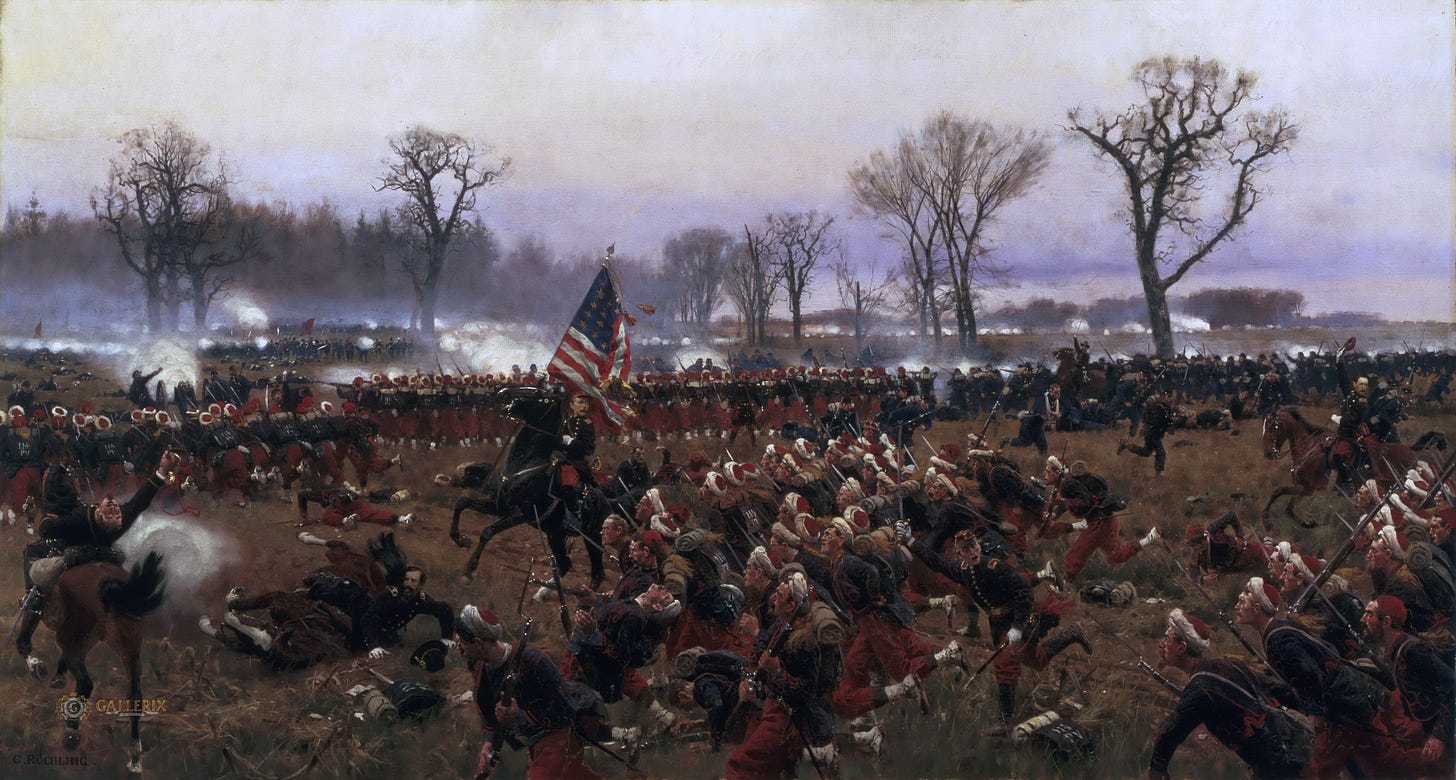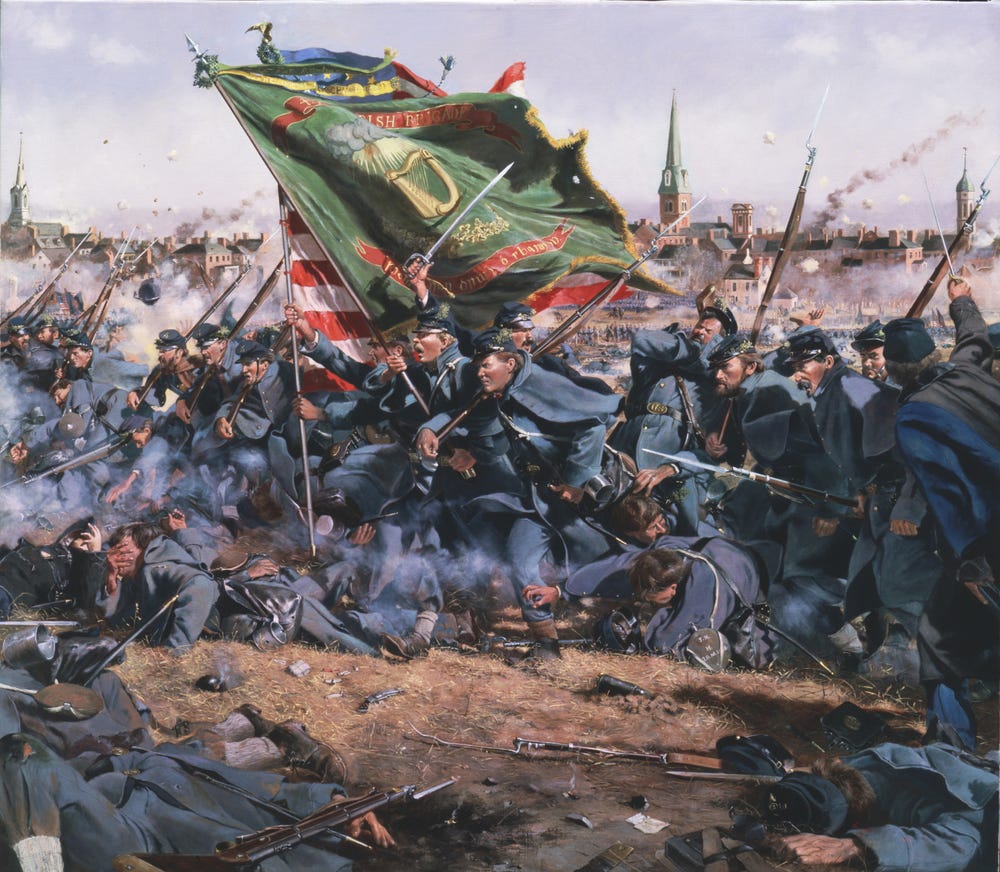Today is the 160th anniversary of the battle of Fredericksburg. In 2008 I was invited by the National Park Service to deliver an address marking the battle’s anniversary. I used the occasion to talk about how I use Civil War battlefields like Fredericksburg as a teaching tool. Having read it over this morning I thought it might be interesting to share it with a largely new audience, but also as a reflection of my thinking at that time. Much has changed.
Stepping onto the bus in the early morning hours with my students, bound for one of the areas Civil War battlefields, is still my favorite day of the year. For me, it is an opportunity to reconnect with a history that has given my life meaning in so many ways. It’s also a chance to introduce this history to my students, many of whom have never set foot on a Civil War battlefield. Visits to battlefields such as Fredericksburg provide a venue in which to discuss what is only an abstraction in the classroom and offer students and the rest of us a chance to acknowledge a story that is much larger and more remote compared to our individual lives and yet relevant in profound ways.
I suspect that my class visits to battlefields have much in common with what brings you to a place like Fredericksburg. We want to understand what happened here, why it happened, and what it means that it happened. We are compelled to do so. My students and I walk this hallowed ground and try our best to piece together what are often conflicting accounts of the ebb and flow of battle.
At the same time we struggle to understand and honor the courage of the men who fought and “gave the last full measure of devotion.” Some of those stories are well known, such as the one depicted in this beautiful monument dedicated to Sergeant Richard Kirkland of the 2nd South Carolina Volunteers, who in the heat of battle chose compassion over violence and hatred or the combination of fear and steadfastness that animated Sergeant Thomas Plunkett of the 21st Massachusetts, who carried his regimental colors into battle only to receive a direct hit by a Confederate shell which cost him one arm and part of another – his blood forever staining the regiment’s flag.
Though the fighting that took place here at the base of Marye’s Heights has come to dominate our popular imagination, the men who fought on the Confederate right under Lt. Gen. Thomas “Stonewall” Jackson and Major General William B. Franklin deserve our attention as well. Their deeds do not admit of such arbitrary distinctions made well after war’s end.
As we walk this section of the battlefield we do our best to understand the confusion that ensued along the Old Richmond Road, the rail line, and the surrounding woods, all the while relying on the soldiers themselves to speak directly to us. We trace the movements of Major John Pelham’s two-gun crew as they deftly maneuvered to avoid overwhelming Federal artillery and fought to stave off Franklin’s columns. And we follow the men in the 11th Pennsylvania Reserves, Co. E, who took part in the only offensive of the day that resulted in a temporary breakthrough in the Confederate position and left only one man unhurt by day’s end. Finally, we follow the 114th Pennsylvania who charged headlong into a counterattack led by the divisions of Jubal Early and William Taliafero, which eventually succeeded in securing the breach in their line.
I do my very best to render the fighting intelligible for my students and to give them a sense of the character and motivation of the men who fought and died here, but as we all know there are aspects of battle that are best left to the individual and silent contemplation is often instructive.
When positioned below Marye’s Heights I give my students a few moments to reflect on the bravery and steadfastness of the men who marched roughly 600 yards over open ground to what was almost certain death. Following lunch on Telegraph Hill I ask my students to sit alone and think about Robert E. Lee’s poignant words about the nature of battle as he contemplated the bloody scenes unfolding in front of him.
Many of the stories that I share with my students on our trips require us to stretch the traditional definition of the battlefield to include the civilians who were forced to evacuate their homes on the eve of the battle only to return to discover their property in ruins.
And some of these stories require that we look beyond the battlefield entirely and even the four years that defined the war itself. In fact, the first stop on our Fredericksburg tour is the downtown area, not only to discuss the crossing of the Federal army on December 11 and the defense of the town, but also to discuss the significance of the slave auction block on the corner of William and Charles Street. The brief stop serves to remind us that the men who fought in this battle did not simply fall from the sky prepared to kill and maim one another. Americans wrestled with the question of whether a “house divided against itself” could stand and eventually answered it with a resounding, “NO”.
The resulting war and carnage is a sobering reminder of what can only be described as a fundamental failure for our system of government. But if the introduction of war represented a failure then the war itself offered an opportunity to reshape the nation in a way which more clearly embodies our founding ideals.
A short walk from the slave auction block we can see the first glimmers of this possible future in the boyhood home of John Washington, a slave of 24 years, who lived in Fredericksburg and dreamed of one day attaining his freedom following the forced separation from his mother. With the arrival of the Federal army opposite Fredericksburg in Falmouth, Washington made his move. For Washington the Federal army meant the arrival of freedom and on April 18, 1862 he crossed the river thus forever changing the course of his life as well as the nation. Years later, Washington underscored the importance of this day when he wrote in his memoir: “This was the first night of my freedom. It was Good Friday indeed the best Friday I had ever had.”
The courage displayed by Washington on that Good Friday and thousands of other fugitive slaves across Virginia and the rest of the South helped to transform the nation by offering Americans the opportunity to embrace a “New Birth of Freedom.” Indeed, the battle of Fredericksburg helped set in motion a chain of events that resulted in the process of emancipation in 1863 and the eventual end of slavery in December 1865. It is the end of slavery and the realization of freedom for four million slaves that help to give meaning to the brave men who fought and died here.
The overlapping scenes of freshly dug graves and the stroke of a pen on January 1, 1863 constitute the first echoes of exactly what the war was about.
The final stop on our tour, and in my mind the most important stop for anyone visiting this battlefield, is the cemetery that contains the graves of 15,000 United States soldiers.
As I do with all of my student battlefield tours we read together Abraham Lincoln’s Gettysburg Address and consider questions surrounding the consequences of the war. It is my hope that my students – their generation, as much as ours – will come to see themselves as part of a much larger narrative, as part of a larger community that continues to be shaped and defined by the actions and decisions of those who came before us.
It is my responsibility as a teacher and our responsibility as citizens to work to understand both the achievements as well as the failures of the Civil War generation. In large part, the white community of Fredericksburg eventually managed to rebuild their lives and move on. Through reunion ceremonies and monument dedications such as the one, which took place just a few steps from here in honor of Andrew A. Humphreys’s division, former enemies were able to put much of the bitterness and hatred behind them and embrace reconciliation. In doing so they helped to forge a nation whose influence would be felt throughout the twentieth century and the rest of the world.
On the other hand I expect my students to deal with questions that, unfortunately, too few of us are willing to confront. I ask them to consider the consequences of the war for African Americans.
Why did the local African-American community here in Fredericksburg discontinue celebrating Memorial Day just a few short years after Appomattox? What did the battle of Fredericksburg mean, for example, to Joseph Walker, who was born in Spotsylvania County, witnessed the bloody battle in May 1864 and who went on to found the Fredericksburg Normal and Industrial Institute in 1905 at the height of Jim Crow?
What stories did he share with his students about the war that had been lost in the broader movement of national reunion? Finally, what challenges did John Washington face as he struggled to keep alive his own personal story of emancipation for his children and grandchildren? Would Walker, Washington, and other African Americans have been welcomed to this battlefield in 1905? Could they find meaning here at the turn of the twentieth century? What about at the beginning of the twenty-first century?
Such questions are rarely easy to address. Nor should they be. Battlefields are not simply places to visit and retrace the movements of soldiers from point A to B for our own amusement. I expect my students, as well as any visitor to this hallowed ground, to struggle with these and other questions.
We ought to feel just a bit uncomfortable when confronted with so much bloodshed and sacrifice. It is my belief that we honor the sacrifice of the men who fought so bravely here not when we present them as stick figures, disconnected from the causes and consequences of the war or as actors in a comforting morality play, but as full human beings who acted within a broad spectrum of impulses that define the human condition.
We can honor their service and ensure that “these dead shall not have died in vain” by acknowledging the legacy of emancipation and freedom that they helped to bring about, and, in doing so, continue their work of more fully embracing the founding ideals that we as Americans so dearly treasure.






Thank you for this tribute.